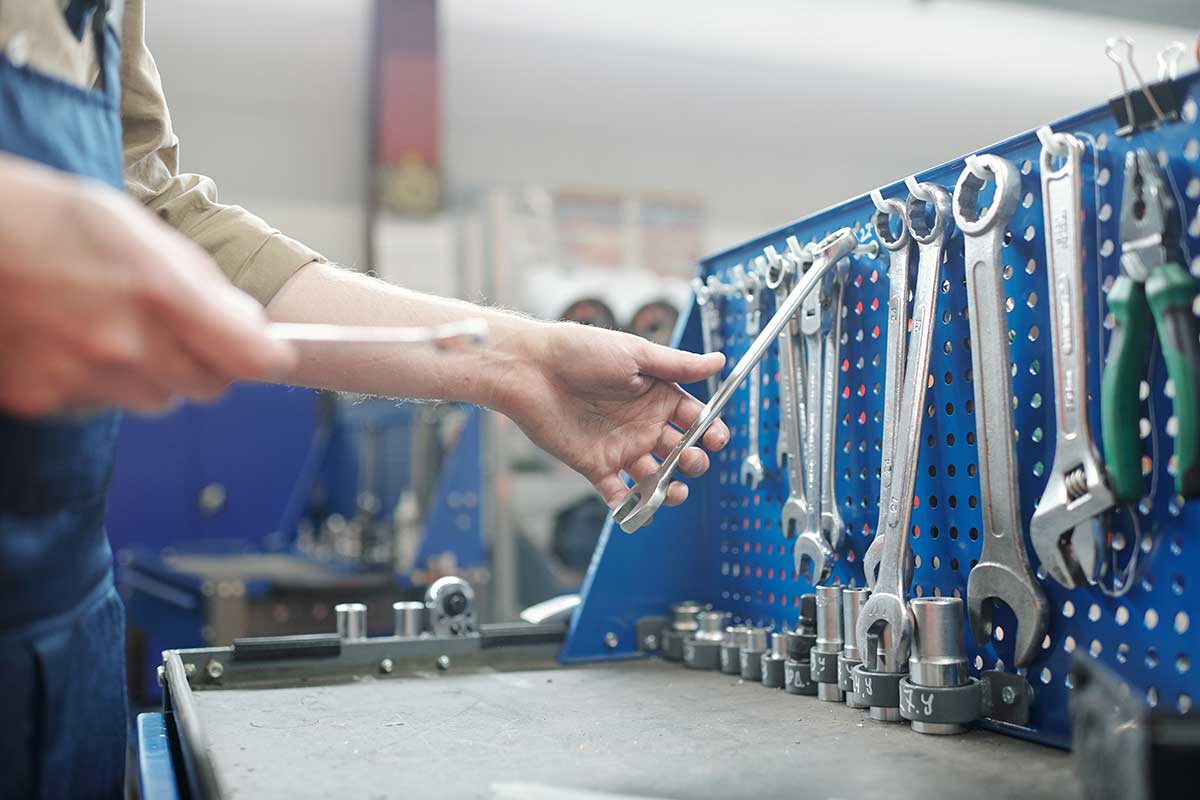

5 Tips and Ideas to Organizing Your Workbench
By Grainger Editorial Staff 9/3/25
Boost productivity and safety with these practical ideas for better workbench organization. Get tips to assess your space, store tools efficiently, label gear and use lighting to create a cleaner, more functional workspace in any facility.
Let's face it, a spotless workbench is a rare sight in the middle of a busy day. A bit of clutter is understandable. But letting that clutter overwhelm your space? That's a recipe for trouble. Not only does it look bad, but it can also make your workspace unsafe and inefficient. Learn simple ways you can introduce some order to your workspace. From separating screws and drill bits to securing your power tools and batteries, learn how to create an organized workbench that will help make projects faster, safer and more enjoyable.
1. Assess Workspace Needs
Before organizing, evaluate your workbench layout and identify the types of projects you typically work on. Make a list of your most commonly used tools and consider any storage constraints in your workspace. Apply the 5S methodology to help eliminate unnecessary clutter and group similar tools together to create task-specific zones. Consider making zones for your frequently used equipment, power tools, hand tools, hardware and fasteners. Maximizing the use of your available space not only makes work more efficient but also makes for a safer and more productive environment.
2. Make Tools Reachable
Not every facility has unlimited space. This is where configurable workbenches and pegboards come in handy. This setup allows you to hang and store tools on the wall while still being within reach. A pegboard can hold adjustable hooks and bins for tools of all sizes, from power saws to stray nuts and bolts. With a pegboard handy, everything has a place and there's a place for everything. Another option is using magnetic bars to mount tools close to your workbench. Installing workbenches with drawers, bins and totes can provide extra storage to help keep everything tidy. Use dividers to systematize small items, like nails and screws and wall-mounted cabinets to make practical use of the area. Consider making your workbench mobile with a rolling tool cabinet, allowing you to move tools quickly and safely anywhere in your facility.
3. Color Code or Label Everything
Color coding tools and equipment with different colored tape or labels is a quick and easy way to differentiate between similar items without closely inspecting each one. Labeling everything is another simple way to dramatically cut down on time wasted searching for the right tools, whether you have five employees or 500. Label tools by use or brand. Your workers can even put their names on each piece of equipment, so there are no mix-ups. It may be a time-consuming task, but it's worth doing to improve organization and workflow efficiency. Color coding or labeling frequently used items can help save time and increase productivity in the long term.
4. Outline Your Tools
Outlining your tools on a pegboard or using foam inserts in your drawers or tool cabinets can make putting things back a breeze. Like a puzzle, everything has a spot. It also helps ensure tools are placed back correctly and makes it easy to notice if something is missing. Tip: Don't use anything permanent so you can switch things around in the future.
5. Use Adjustable Lighting
When it comes to accessories for your workbenches, there are plenty of add-ons to choose from. But one of the necessities is light. Each workbench may require different task lighting or power accessories to help brighten up the workspace. The brighter it is, the easier it is to see and keep things organized. You'd be surprised what a little bit of light can do. Choose bulbs based on adjustability. For example, try to find a lamp that can be modified to accommodate working standing or sitting on a shop stool.
Keeping your workbench organized is an ongoing process. Make sure to establish a regular maintenance schedule for your tools and equipment, periodically review and adjust the layout and implement preventative measures to help maintain its cleanliness and overall functionality.
Explore more tips and strategies for bringing order to different workplace areas.
Frequently Asked Questions
Creating a battery charging station near your workbench is a great way to keep your power tools ready and organized. To build your own charging station, start by mounting a shelf or pegboard next to your workbench and attaching multi-port battery chargers to it. Organize the cables with clips or hooks and connect them to a power strip for extra outlets. This setup can ensure all your tools are charged and ready when you need them, and it helps keep your workspace tidy by having one spot for all your chargers, spare batteries and accessories.
Consider using modular tool storage solutions that can be reconfigured as needed. Another option is using a rolling tool cabinet to bring tools to various workstations or project sites. Incorporating both solutions can reduce setup time and improve your productivity by ensuring that the right tools are always within reach and your workspace can adapt to meet the needs of any project.

Safety Management
6 Tips to Help Prevent Slips, Trips and Falls
Identify the fall hazards in your workplace and implement a fall safety program. Check out these tips from Grainger so you can mitigate risk.
![]() Our Latest KnowHow
Our Latest KnowHow

Facility Pest Control: How IPM Helps Safely Manage Insects
Discover safe, compliant pest control with IPM. Find tips for insect monitoring, sanitation and safe insecticide use in commercial facilities.
The information contained in this article is intended for general information purposes only and is based on information available as of the initial date of publication. No representation is made that the information or references are complete or remain current. This article is not a substitute for review of current applicable government regulations, industry standards, or other standards specific to your business and/or activities and should not be construed as legal advice or opinion. Readers with specific questions should refer to the applicable standards or consult with an attorney.














